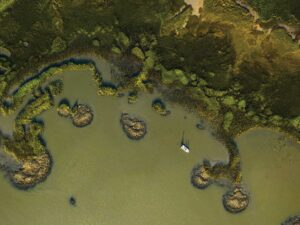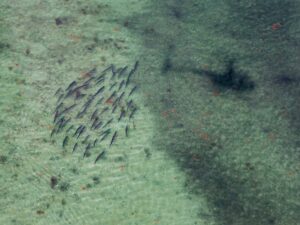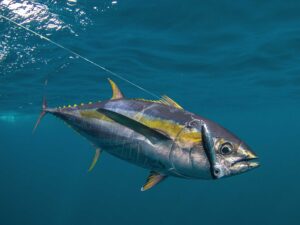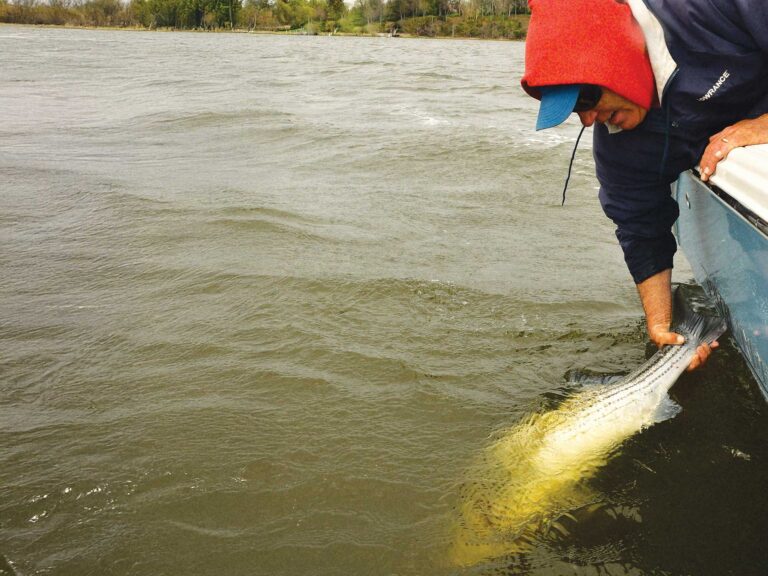
From my vantage point on the flying bridge, I heard the port outrigger clip crack like a rifle shot. In the cockpit below, a rapid-fire Spanish exchange followed as the crew scampered to clear the remaining lines. Jorge Saca muscled the bent rod from the gunwale holder and settled into the fighting chair. As the Dacron line spun off the reel in a neon blur, we watched the billfish double the distance from the boat with a sequence of long, spastic leaps just above the waterline.
“Now that’s what we came for,” Paco Saca shouted happily as I stood next to him on the flying bridge. “Pacific blue marlin. That’s the prettiest sight in the world to me.” With the elder Saca deftly maneuvering the throttles of Sandy-ita, his 45-foot Rampage convertible, and his stocky son pumping and winding in unison, the fight was quickly over. After celebratory photos and a well placed jab from the tag stick, the tired 250-pounder glided back into the iridescent depths.
When Jorge invited me to sample El Salvador’s blue-water fishery last January, I didn’t know what to expect. But he quickly assured me that despite its size, El Salvador’s diminutive Pacific coastline had big-game action to rival its larger neighbors.
“Our best day, we caught and released five blues out of eight raised,” he told me. “That was a great day. But we average two to three marlin every time we go out, plus a steady mix of sails and dorado.” In testament to that claim, we had boated a 30-pound dorado and released a hefty sailfish prior to our encounter with the blue marlin.
“I mainly target marlin, so we normally start fishing in 300 feet and work our way out,” Paco added. “That’s about 35 miles from the inlet. If you go another 10 miles beyond that, you’ll be in 3,000 feet of water. You’ll catch plenty of sails and dorado in close. Whenever I see a bill behind the lure and the fish doesn’t pounce on it right away, I know it’s a sail. We also take quite a few dorado off floating logs and other debris that washes out during the rainy season.”
Because of the possibility of big fish, Paco prefers to troll 50- and 80-pound-class conventional outfits. His spread consists of two outrigger rods per side and a single shotgun bait down the middle. A pair of flat lines off the transom corners substitute for teasers. All rods are numbered for easy maintenance, and loops of waxed rigging floss are tied to the running lines for quick repositioning after a strike.
Covering more water, lures are the bait of choice among the dedicated marlin chasers. Hawaiian styles are the local favorite.
“This is Bart country,” Paco explains. “Everybody fishes at least a couple Black Bart lures. He named one the El Salvador Blue after it raised a grander the first time it was fished here.”
Paco keeps the Sandy-ita at a steady 7 1/2 knots when he’s on the troll.
“People think you have to go fast for marlin,” he says. “But you don’t. The speed of the lures isn’t as important as the action. It’s like the old Alka-Seltzer commercial: They need to plop, plop, fizz, fizz. And at 7 1/2 knots, they’re always smoking.”
Blue marlin roam El Salvadorian waters all year, but June, July and August offer the greatest number of fish. Size averages from 300 to 400 pounds during this time. True giants frequent these waters too. As proof, Paco showed me the footage of two epic battles waged by his younger son, Javier, and Jorge with blues that could have easily eclipsed the grander mark. Both fish were successfully released.
Summer months are also the best time for trophy yellowfin tuna in deeper water, although Paco’s personal best – a 208-pounder – came in January. His largest dorado to date, a 62-pounder, was boated in August. With calm seas, light winds and water temperatures approaching the 90s during summer months, the fish prefer the cooler thermoclines below the surface.
“Marlin fishing takes time,” Paco tells me. “You have to be patient and enjoy the moment. A bad day can turn good very quickly.”
My host’s optimistic approach didn’t quite pan out on my last day. Although we did raise three smaller blues and missed our one hookup, the big girls eluded us. That’s OK. It just gives me another excuse to go back there, off the beaten path.
TACKLE BOX

Rods: 7-foot trolling rods or 5 1/2- to 6-foot stand-up rods in 80-, 50-, 30- and 20-pound class.
Reels: Conventional reels with large line capacities and smooth drags matched to the rods.
Lines: Dacron lines with monofilament top shots: 24 feet of 450- to 500-pound monofilament leader, with 12 feet of doubled line for marlin and tuna. The Aussie braid is more popular here than the Bimini twist for connections.
Hooks: 7/0 to 11/0, depending on lure size.
Lures: Hawaiian-style acrylic plungers in black, purple, silver and pink variations, along with soft plastic swimmer- and chugger-style lures.
Baits: Ballyhoo rigged behind jet lures. Bait-and-switch is also a popular tactic for sails.
**

**
TRIP PLANNER
What: Pacific blue marlin, sailfish, yellowfin tuna and dorado.
When: Year-round action. The average offshore water temperature stays in the 80-degree range. The rainy season typically runs from November through March.
Where: Located 40 minutes southeast of the Comalapa International Airport, near the capital of San Salvador, Bahia del Sol Hotel and Casino is the hub for the country’s big-game fishing. The comfortable facility has town houses, single- to triple-occupancy deluxe suites, two restaurants, and Wi-Fi in the lobby. The marina is well protected inside the lagoon, while the ocean beaches are within walking distance across the main highway. bahiadelsolelsalvador.com.
Who: A well equipped, modern fleet of local charter boats stands ready to help you take advantage of the productive offshore waters of El Salvador.
Bahia del Sol
Marco Antonio Zablah
011-503-2510-7200
www.bahiadelsolelsalvador.com
Blue Sail Charters
Juan Carlos Sanchez
225-763-1349
www.bluesailcharters.com
For-Tuna Charters
Marco Guirola
011-503-7860-7392
marco@fonomed.com
Paradise Fishing Lodge
Isabel Salazar
302-678-3794
www.paradisefishinglodge.net









